Sclerotherapy
In the weeks following the treatment, the hardened blood vessel is absorbed into the surrounding tissue, eventually becoming barely noticeable or invisible. Blood circulation is then carried out through healthy veins located deeper within the body, which significantly reduced the so the appearance and pain associated with the problematic veins.
SCLEROTHERAPY EXAMPLES
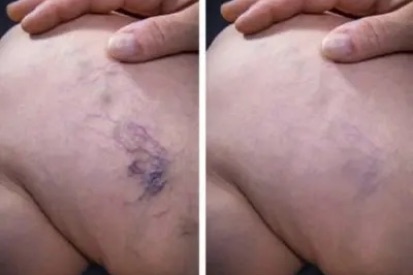
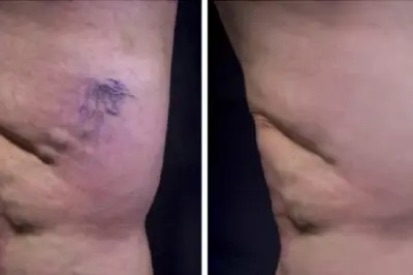
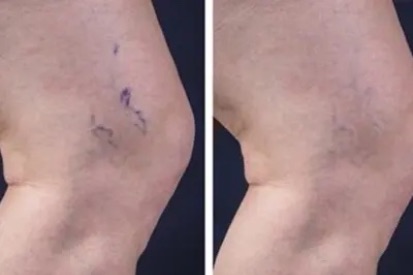
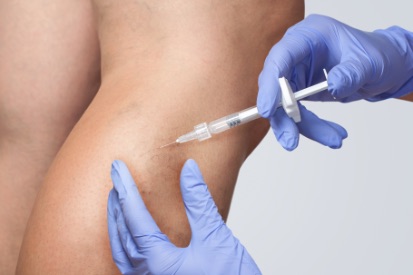
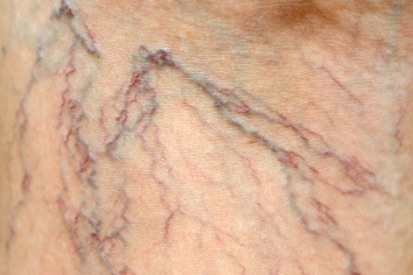
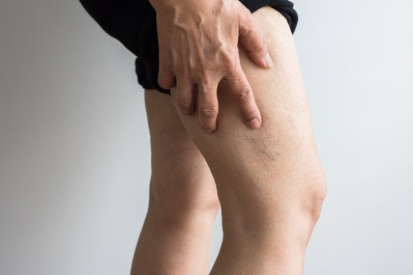
Benefits of Sclerotherapy
- Effective: Highly effective in treating small varicose and spider veins.
- Minimally Invasive: Does not require surgery and typically takes less than an hour to complete.
- No Downtime: Can usually resume normal activities immediately after treatment.
- Improved Appearance: Significantly improves the appearance of varicose and spider veins.
- Pain Relief: Alleviates symptoms such as aching, swelling, and burning in the legs associated with varicose veins.
- High Success Rate: High success rate, especially for small veins.
- Non-Scarring: Usually does not result in scarring.
Common Side Effects of Sclerotherapy
- Bruising: Bruising at the injection site is common.
- Redness or Discoloration: Temporary redness or discoloration of the skin around the treated area.
- Itching: Itching may occur at the site of the injected veins.
- Swelling: Swelling of the legs or ankles may occur temporarily.
- Allergic Reaction: Some individuals may experience an allergic reaction to the sclerosing agent.
- Hyperpigmentation: The skin around the treated area may darken, but this is usually temporary.
- Matting: The development of new, tiny blood vessels near the treated area can occur but often resolves over time.
What to Expect at Your Sclerotherapy Appointment
Sclerotherapy Maintenance Recommendations
- Wearing Compression Garments: To help maintain pressure on the treated veins and reduce the risk of blood pooling.
- Regular Exercise: Engaging in regular, low-impact exercise, such as walking or swimming, can help improve circulation and prevent the formation of new varicose or spider veins.
- Maintaining a Healthy Weight: Can reduce the pressure on your veins and lower your risk of developing new varicose or spider veins.
- Avoiding Prolonged Sitting or Standing: Try to avoid sitting or standing for long periods without taking breaks.
- Elevating Your Legs: Elevating your legs when resting can help reduce swelling and improve circulation.
- Follow-Up Appointments: Attend follow-up appointments as recommended by your dermatology provider to monitor your progress and address any new vein issues that may arise.
- Skin Care: Care for your skin by keeping it moisturized and protecting it from the sun to prevent skin damage and reduce the risk of hyperpigmentation.
Sclerotherapy Maintenance Schedule
- Follow-up Appointments: Usually scheduled 4-6 weeks after the initial treatment to assess the results and determine if additional sessions are needed.
- Additional Treatments Sessions: If needed, additional sclerotherapy sessions may be scheduled every 4-6 weeks until the desired results are achieved. Some individuals may only require one session, while others may need multiple sessions.
- Annual Check-ups: After the initial treatment is completed and the desired results are achieved, annual check-ups with your dermatology provider may be recommended to monitor the condition of your veins and address any new issues that may arise.
Sclerotherapy FAQs
Varicose veins are enlarged, dilated, and overfilled blood vessels cause by insufficient blood circulations and weak vascular walls. Varicose veins usually require treatment by a vascular surgeon, interventional radiologist or other physician with expertise in removing these types of veins.
Spider veins are caused by compromised blood vessels due to weak vascular walls and inefficient blood circulation. They are a milder variation of varicose veins and refer to the smaller, reddish to purple veins near the surface of the skin. They're usually treated in a dermatology setting using less-invasive treatments, such as sclerotherapy.
Unfortunately, spider veins and varicose veins usually cannot be prevented. However, there are a few things one can do to minimize unwanted blood vessels from forming such as wearing support hose and compression socks, maintaining a healthy weight, exercising regularly, eating a high-fiber diet, wearing low-heeled shoes, and using adequate sun protection.
Sclerotherapy treats spider veins and milder forms of varicose veins by damaging the compromised blood vessels with a sclerosing agent, which causes blood flow to reroute to healthier veins located deeper in the body. Over time, this damaged vein is absorbed into the surrounding tissue and fades away completely.
The marks and bruising from the sclerosing agent resolve in about 6-8 weeks, but there is no significant recovery time for sclerotherapy.
Your dermatology professional will provide you with some important recovery steps after your treatment. This may include frequent walking to get the sclerosing solution out of circulation and bandages on the injected areas post-treatment. They will also instruct you to keep the treated vessels compressed, as this may help seal the treated vessels and seal the blood from clotting under the skin, reducing the development of dark spots.
We highly recommend patients wear compression bandages or stockings following a sclerotherapy treatment. This helps to keep blood circulating and reduce the development of dark spots.
